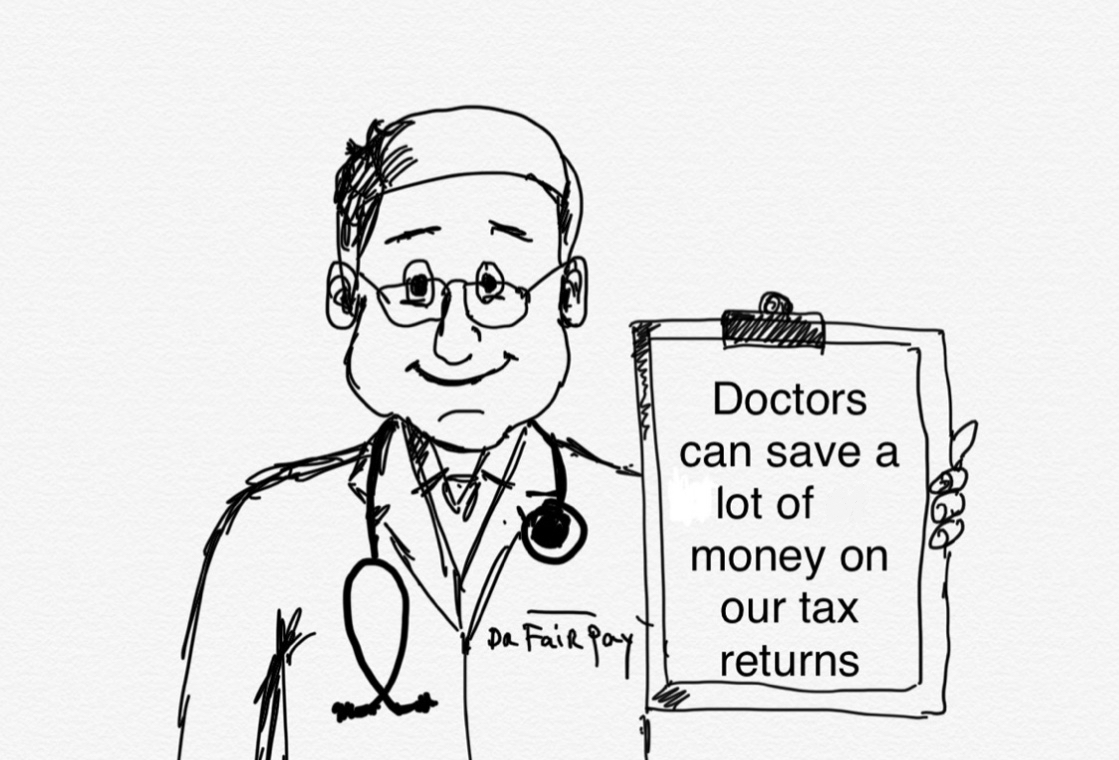How to Reduce your Taxes
We at FairPayDoctor.com want not only to promote transparency in the physician job market, but also to help empower doctors. There may be no better way to do that than to put more money back into your pockets. With that in mind, we present here a guide to reducing your tax bill. We’ll split this into two sections, depending on whether you are a 1099/owner or a W-2 (employee).

1099 / Business Owners
The best way to reduce your taxes is to have greater control over your finances. That means being a business owner or 1099 as opposed to a W-2/employee. We asked other physicians in the Passive Income Docs Facebook group. Here are some of the tips they gave (with some of our own commentary):
- Set up an LLC (or PLLC) and elect S-corp taxation. You can do this by filing Form 2553 with the IRS.
- Set up a 401k. When you set this up, make sure you allow in-service withdrawals and after-tax contributions so you can take advantage of the mega backdoor Roth. As a result, we recommend this instead of a SEP IRA.
- Pay yourself as little W-2 income as needed from your corporate bank account. (Use a payroll service to reduce headaches and potential fines for improperly paid taxes.) Do this to minimize the amount of payroll taxes you’ll owe. However, you will still have to pay yourself a reasonable amount. You’ll also have to pay yourself at least as much money as you want to put into your 401k.
- Contribute to a defined benefit pension plan. DBPs have gotten a bad rap as of late, but if you’re in control, they can be a great way to reduce your taxable income. There are different types, including traditional and cash balance. You should be able to put away up to $225k tax-deferred. You can have both this and a 401k.
- Get a dedicated credit card for all business/work expenses.
- Pay any expense that qualifies as a business expense, but make sure to properly track them. Remember, every single dollar spent is an opportunity to cut or even not pay taxes. For example:
- Uniform, any equipment needed for work (stethoscope, laptop)
- Cell phone and service
- Medical licenses and DEAs
- CME
- Travel and lodging for CME or for work
- Cost of looking for work (advertising, travel)
- Vehicle lease or heavy vehicle purchase with accelerated depreciation for transport between home office and patient office/hospital. Check out Section 179 and make sure the heavy vehicle is more than 6,000 lb gross vehicle weight.
- Set up your own captive insurance company, but be careful as the IRS is cracking down on some of these as abusive tax shelters.
- Section 280A(g) – Special rule for certain rental use. You can rent out your own residence to your business for meetings and business parties as long as the rent is fair market and you do not exceed 14 days a year.
- Take advantage of Section 199A QBI deductions, if you qualify.
Do the above and you can get the tax rate on an income in the $500k range down close to single digits!
We didn’t mention this above since very few people will be able to do this, but if you can swing it, there are apparently some big benefits to moving to Puerto Rico for at least half the year. In addition to a 0% federal income tax if your sole income is based in Puerto Rico, Acts 20 and 22 allow for a 4% corporate tax rate if your business exports services beyond Puerto Rico (such as telemedicine or teleradiology) and a 0% capital gains and dividend taxes. Read more here.

W-2
If you are a W-2, your ability to take advantage of the aforementioned tactics is limited. However, that doesn’t mean you should throw up your hands and fork over all your money to Uncle Sam. You still have a couple options. One, you can find a position as a 1099 and thereby take advantage of the above-mentioned tactics. Two, you can do things available to everyone like tax loss harvesting, backdoor Roth, taking advantage of federal and state tax credits related to solar energy, etc. Other helpful advice (again with some of our own commentary) as provided by posters at the Physicians on Fire Facebook group include:
- Invest in opportunity zones to offset realized capital gains
- Municipal bonds (tax-free bonds depending on the locality/state)
- UTMA/UGMA (transfer money to your kids since they have a lower tax-rate than you)
- Maximize contributions to 401k/403b and 457b as available to you (this is a no brainer for pretty much everyone reading this)
- HSA and limited FSA (If you have a qualifying HDHP, you can put money in an HSA. These are commonly referred to as triple tax advantaged, but in reality, they are quadruple tax advantaged. You can still have a limited FSA to pay for dental and vision expenses.)
- FSA, both medical and dependent care (You can’t have a full FSA if you have an HSA. You can have a dependent care FSA, however.)
- 529 plans if your state allows a deduction (a good idea even if your state doesn’t allow a deduction, to be honest)
- Speak with a tax strategist or advisor (different from a CPA, as most CPAs do not do much in the way of suggesting less traveled ways to save on taxes)
- Charitable donations or DAF
- Home office
- Tax-efficient fund placement of dividend-producing stocks, bonds, and REITs (you don’t want to put a REIT in your taxable brokerage account, for example)
- Invest in cash-flowing real estate and take advantage of depreciation rules

We realize that these suggestions are provided without a ton of background info on each strategy. There are some great resources at Physicians on Fire, Passive Income MD, and other sites. Comment below with some questions or topics you want covered in more detail, and we’ll be happy to either point you in the right direction or write a future blog post about it.
As always, we encourage you to give back to the physician community by signing up at FairPayDoctor.com and completing a survey or two about your current or prior jobs. Stay up to date with the latest developments by joining our Facebook group. We and your fellow doctors thank you in advance!
What is a good way to set up 401(k) for my 1099?
We like Vanguard. Suggest contacting them and asking if they will allow in-service distributions and after-tax contributions before setting it up, though. Good luck!